
5 Hydrangea Varieties That’ll Add Some Colour To Your Garden
Hydrangeas look great in any garden, with a range of colours, sizes and shapes available. The huge variation means they will fit into a modern planting plan, as well as a more traditional landscape.
There’s a hydrangea variety for every space, so let’s look at which ones to grow, and the different ways you can use them to impress.
5 Hydrangea Varieties to Grow in Your Garden
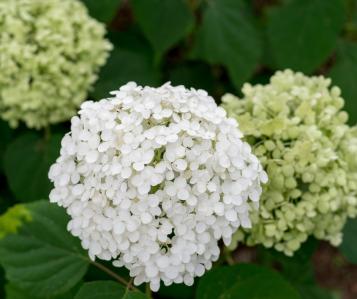
Smooth Hydrangeas
(Hydrangea arborescens)
A deciduous hydrangea that grows at most to 3m tall. It is ideally placed in the middle of a border with lower-growing plants in front, against a backdrop of taller shrubs and trees.
This species prefers partial shade, but will tolerate full sun, and prefers neutral to slightly acidic soil. Water well in dry conditions, adding a layer of Debco® Natural Designer Mulch annually to help retain moisture. Use Scotts Osmocote® All Purpose Controlled Release Fertiliser annually, and prune to ground level in the Winter or early Spring.
We especially like the cultivar ‘Annabelle’, which has large snowball-like blooms that grow up to 30cm across. These flowers will turn from white to green as they mature, giving the impression that it is a green hydrangea. Another similarly beautiful cultivar of Hydrangea arborescens is ‘Grandiflora’, with sweet-smelling blooms of up to 20cm across which are pure white in colour.
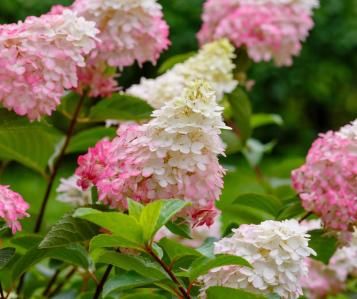
Panicle Hydrangeas
(Hydrangea paniculata)
A shrub or small tree which can grow up to 5m, the panicle hydrangea is known for its conically shaped upright flowerheads (panicles). The dark green foliage of this species is deciduous and has attractive tooth-edged leaves. New flowers emerge as a pale green colour, turning to creamy white or pink-white as they mature. The panicles of flowers can reach up to 30cm long and remain attractive even as they start to die off.
Panicle hydrangeas prefer full sun and should be pruned hard in early spring by cutting back old stems to about four buds. This will encourage more prolific blooms later in the year.
Plant out in early autumn, adding Scotts Osmocote® Compost Premium Soil Improver to the soil first. Popular varieties to grow include ‘Great Star’, with propellor-shaped florets, and ‘Limelight’, which has very dense panicles. An exciting new compact cultivar of Hydrangea paniculata is 'Sundae Fraise', with red stemmed stems and flowers which turn from white to pink and finally red, at full maturity.
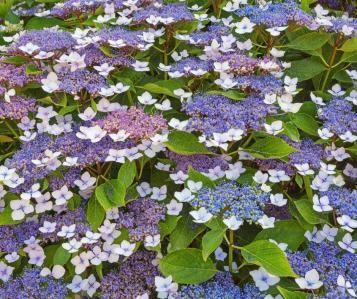
Rough-leaved Hydrangeas
(Hydrangea aspera)
This species of hydrangea produces flattish heads of flowers which are typically purple or pink, with paler florets of white, pink or purple around the edge. The long deciduous leaves are dark green and have a gentle but rough velvety texture, hence its common name ‘Rough-leaved hydrangea’.
It can grow to 3m tall and wide, so give it plenty of space to grow. Plant out from late Spring to early Autumn, and prune to maintain shape in early Spring. It enjoys partial shade but will tolerate full sun, and prefers neutral to acidic soil. It needs plenty of moisture, so water well in hot weather, and use Debco® Pine Bark Designer Mulch annually to retain moisture.
Try Hydrangea aspera ‘Villosa Group’ and 'Macrophylla' cultivars. The striking purple-pinks of these cultivars will look stunning towards the back of a border, with the woody stems providing interest even through the Winter!
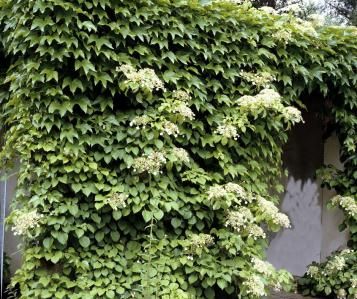
Climbing Hydrangea
(Hydrangea petiolaris)
A vigorous climber, Hydrangea petiolaris is a woody plant that can grow to 15m high. It is perfect for disguising an unattractive wall or fence, although it will need some support, such as a trellis or wires, to climb up. It is slow to get going, but will quickly dominate a space if allowed. This is no bad thing, as the flowers of the climbing hydrangea are beautiful and can brighten a dark, shady space.
They are happy in heavy or partial shade, and deciduous types will tolerate cold conditions. Some types of climbing hydrangea are evergreen, providing year-round interest, but need more warmth. Plant out in late Spring or early Autumn, and prune in late Summer after flowering.
We love the variegated Hydrangea anomala subsp. petiolaris ‘Mirranda’, which has a pale yellow edging to the leaves, and Hydrangea anomala subsp. petiolaris ‘Silver Lining’ which has silver edging. Hydrangea anomala subsp. petiolaris 'Flying Saucer’ is another great cultivar which is grown for its prolific plumes of white flowers.
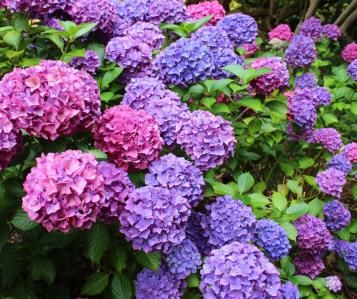
French Hydrangeas
(Hydrangea macrophylla)
Also known as Hortensia, Mophead or Lacecap hydrangeas, this is the most common type of big-leaved hydrangeas found in home and gardens. They are relatively easy to care for, however, they need sunlight and warmth to produce new flower buds, and should only be pruned lightly, if at all, in the Winter. Older flower heads can be kept indoors as decorative dried flowers.
The flower colour of hydrangea macrophylla varies depending on the soil pH level. Acidic soil (pH lower than 6.0) produces blooms that are blue and lavender in colour and alkaline soils (pH above 7.0) promotes pink and red blooms. You can apply pH adjusting products to change hydrangea colour, be mindful that many plants are particularly sensitive to pH changes and changes in colour may take months to appear.
There are lots of attractive hydrangea macrophylla cultivars to choose from, falling into two groups:
- Lacecap types have a dense growth of small flowers surrounded by a few larger florets on the outside;
- Mophead types do not have the inner dense growth of smaller florets, and instead have a single clump of larger florets.
We love the Mophead cultivars ‘Altona’, Ayesha’ and ‘Holstein’, and the Lacecap cultivars ‘Zorro’, ‘Veitchii’ and ‘Koria’. ‘You & Me Together’ is a new form of Hydrangea macrophylla which has double-headed mophead flowers that change colour considerably as the season progresses.
Tips for Landscaping with Hydrangeas
As you can tell, hydrangeas are so varied that their use in the garden is quite versatile. Use them as follows:
- Wildlife haven: As part of a larger selection of plants to help wildlife, Hydrangea can play their part in attracting pollinators to the garden. Smooth hydrangea are wonderful for attracting bees and butterflies, providing an important source of nectar and pollen.
- Part of a container collection: A group of potted plants can create an attractive feature in a corner of the garden or patio. Choose pots which complement the colours of the plants, and opt for a compact variety such as Hydrangea macrophylla ‘Altona’. Keep containers well watered as they can dry out easily, and Hydrangea need moist but well-drained soil to produce their beautiful flowers.
- Lighting up a shady spot: As most hydrangea will tolerate or even enjoy shady conditions, they are perfect to plant in a location in which other plants may struggle. Hydrangea macrophylla are perfect among or behind other plants, and Hydrangea petiolaris are good for giving height to an otherwise uninteresting corner.
- Single colour theme: Hydrangea flowers which are unaffected by acidity or alkalinity levels have a predictable colour, so use them as part of a single coloured border. Try white-flowering cultivars or any of the different species above, mixed in with other similarly coloured flowers, such as Philadelphus and tulips.
- Privacy: The height of most Hydrangea lend them to providing screening and seclusion. Hydrangea paniculata and Hydrangea aborescens are ideal for this, growing to a height which is above the eyeline of passers by. At the same time their flowers are attractive enough to give an informal hedge line that doubles up as a pretty boundary.
- Symmetrical path planting: Plant clumps of Hydrangea macrophylla opposite one another on either side of a path to create a formal approach to a front door. This species is small enough that the effect of symmetrical planting is really striking, especially if other plants are used in the same way. Try alongside Salvias and Hostas.
- Soften a fence line: All species of hydrangea can be used to soften a hard fence line. They can provide depth and height, with densely planted Hydrangea macrophylla giving the effect of a low hedge. Use Hydrangea petiolaris to disguise high, unsightly fencing.
- Formal arrangement: Grow hydrangea as part of a precise arrangement, with other plants placed in a deliberate and orderly fashion. This is very well suited to a modern garden, where exacting shapes give a crisp and clean impression. Use Hydrangea macrophylla with ornamental grasses and box (Buxus sempervirens).







